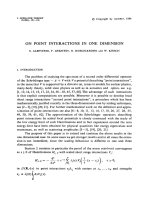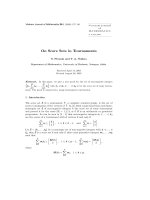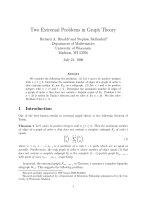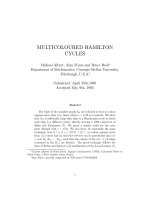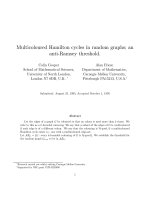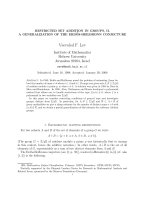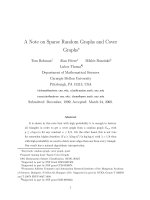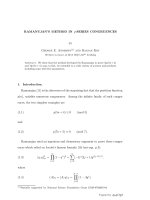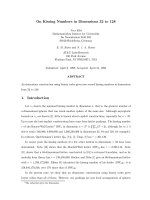Báo cáo toán học: "Multicoloured Hamilton cycles in random graphs; an anti-Ramsey threshold" pot
Bạn đang xem bản rút gọn của tài liệu. Xem và tải ngay bản đầy đủ của tài liệu tại đây (196.81 KB, 20 trang )
Multicoloured Hamilton cycles in random graphs; an
anti-Ramsey threshold.
Colin Cooper
School of Mathematical Sciences,
University of North London,
London N7 8DB, U.K.
∗
Alan Frieze
Department of Mathematics,
Carnegie Mellon University,
Pittsburgh PA15213, U.S.A.
†
Submitted: August 25, 1995; Accepted October 1, 1995
Abstract
Let the edges of a graph
G
be coloured so that no colour is used more than
k
times. We
refertothisasa
k
-
bounded colouring
. We say that a subset of the edges of
G
is
multicoloured
if each edge is of a different colour. We say that the colouring is
H
-good
, if a multicoloured
Hamilton cycle exists i.e., one with a multicoloured edge-set.
Let
AR
k
=
{
G
:every
k
-bounded colouring of
G
is
H
-good
}
. We establish the threshold for
the random graph
G
n,m
to be in
AR
k
.
∗
Research carried out whilst visiting Carnegie Mellon University
†
Supported by NSF grant CCR-9225008
1
the electronic journal of combinatorics 2 (1995), #R19 2
1 Introduction
As usual, let G
n,m
be the random graph with vertex set V =[n]andm random edges. Let
m = n(log n +loglogn + c
n
)/2. Koml´os and Szemer´edi[14]provedthatifλ = e
−c
then
lim
n→∞
Pr(G
n,m
is Hamiltonian) =
0 c
n
→−∞
e
−λ
c
n
→ c
1 c
n
→∞
,
which is lim
n→∞
Pr(δ(G
n,m
) ≥ 2), where δ refers to minimum degree.
This result has been generalised in a number of directions. Bollob´as [3] proved a hitting time version
(see also Ajtai, Koml´os and Szemer´edi [1]); Bollob´as, Fenner and Frieze [6] proved an algorithmic
version; Bollob´as and Frieze [5] found the threshold for k/2 edge disjoint Hamilton cycles; Bollob´as,
Fenner and Frieze [7] found a threshold when there is a minimum degree condition; Cooper and
Frieze [9], Luczak [15] and Cooper [8] discussed pancyclic versions; Cooper and Frieze [10] estimated
the number of distinct Hamilton cycles at the threshold.
In quite unrelated work various researchers have considered the following problem: Let the edges of
agraphG be coloured so that no colour is used more than k times. We refer to this as a k-bounded
colouring. We say that a subset of the edges of G is multicoloured if each edge is of a different
colour. We say that the colouring is H-good, if a multicoloured Hamilton cycle exists i.e., one with
a multicoloured edge-set. A sequence of papers considered the case where G = K
n
and asked for
the maximum growth rate of k so that every k-bounded colouring is H-good. Hahn and Thomassen
[13] showed that k could grow as fast as n
1/3
and conjectured that the growth rate of k could in
fact be linear. In unpublished work R¨odl and Winkler [18] in 1984 improved this to n
1/2
.Frieze
and Reed [12] showed that there is an absolute constant A such that if n is sufficiently large and k
is at most n/(A ln n) then any k-bounded colouring is H-good. Finally, Albert, Frieze and Reed
[2] show that k can grow as fast as cn, c < 1/32.
The aim of this paper is to address a problem related to both areas of activity. Let AR
k
= {G :
the electronic journal of combinatorics 2 (1995), #R19 3
every k-bounded colouring of G is H-good}. We establish the threshold for the random graph G
n,m
to be in AR
k
.
Theorem 1 If m = n(log n +(2k − 1) log log n + c
n
)/2 and λ = e
−c
, then
lim
n→∞
Pr (G
n,m
∈AR
k
)=
0 c
n
→−∞
k−1
i=0
e
−λ
λ
i
i!
c
n
→ c
1 c
n
→∞
(1)
=lim
n→∞
Pr(G
n,m
∈B
k
),
where B
k
= {G : G has at most k − 1 vertices of degree less than 2k}.
Note that the case k = 1 generalises the original theorem of Koml`os and Szemer`edi. We use AR
k
to denote the anti-Ramsey nature of the result and remark that there is now a growing literature
on the subject of the Ramsey properties of random graphs, see for example the paper of R¨odl and
Ruci´nski [17].
2 Outline of the proof of Theorem 1
We will prove the result for the independent model G
n,p
where p =2m/n and rely on the mono-
tonicity of property AR
k
to give the theorem as stated, see Bollob´as [4] and Luczak [16]. With a
little more work, one could obtain the result that the hitting times for properties AR
k
and B
k
in
the graph process are coincidental whp
1
.
We will follow the basic idea of [12] that, given a k-bounded colouring we will choose a multicoloured
set of edges E
1
∪ E
2
and show that whp H =(V =[n],E
1
∪ E
2
) contains a Hamilton cycle. E
1
is
chosen randomly, pruned of multiple colours and colours that occur on edges incident with vertices
of low degree. E
2
is chosen carefully so as to ensure that vertices of low degree get at least 2 incident
1
with high probability i.e. probability 1-o(1) as n
→∞
the electronic journal of combinatorics 2 (1995), #R19 4
edges and vertices of large degree get a substantial number of incident edges. H is multicoloured
by construction. We then use the approach of Ajtai, Koml´os and Szemer´edi [1] to show that H is
Hamiltonian whp.
3 Required graph properties
We say a vertex v of G = G
n,p
is small if its degree d(v)satisfiesd(v) < log n/10 and large otherwise.
Denote the set of small vertices by SMALL and the remaining vertices by LARGE. For S ⊆ V we
let
N
G
(S)=N(S)={w ∈ S : ∃v ∈ S such that {v,w} is an edge of G}.
We now give a rather long list of properties. We claim
Lemma 1 If p =(logn +(2k − 1) log log n + c)/n then G
n,p
has properties P1 – P9 below whp and
property P10 with probability equal to the RHS of (1).
P1 |SMALL|≤n
1/3
.
P2 SMALL contains no edges.
P3 No v ∈ V is within distance 2 of more than one small vertex.
P4 S ⊆ LARGE, |S|≤n/ log n implies that |N(S)|≥|S| log n/20.
P5 T ⊆ V, |T|≤n/(log n)
2
implies T contains at most 3|T| edges.
P6 A, B ⊆ V, A ∩ B = ∅, |A|, |B|≥15n log log n/ log n implies G contains at least |A||B| log n/2n
edges joining A and B.
P7 A, B ⊆ V, A∩B = ∅, |A|≤|B|≤2|A| and |B|≤Dn log log n/ log n (D ≥ 1) implies that there
areatmost10D|A| log log n edges joining A and B.
the electronic journal of combinatorics 2 (1995), #R19 5
P8 If |A|≤Dn log log n/ log n (D ≥ 1) then A contains at most 10D|A| log log n edges.
P9 G has minimum degree at least 2k − 1.
P10 G has at most k − 1 vertices of degree 2k − 1.
The proof that G
n,p
has properties P1–P4 whp can be carried out as in [6]. Erd˝os and R´enyi [11]
contains our claim about P9, P10. The remaining claims are simple first moment calculations and
are placed in the appendix.
4 A simple necessary condition
We now show the relevance of P9, P10. Suppose a graph G has k vertices v
1
,v
2
, ,v
k
of degree
2k − 1 or less and these vertices form an independent set. (The latter condition is not really
necessary.) We can use colour 2i −1atmostk times and colour 2i at most k − 1 times to colour the
edges incident with v
i
,1≤ i ≤ k − 1. Now use colours 2, 4, 6, ,2k − 2 at most once and colour
2k − 1atmostk times to colour the edges inicident with v
k
. No matter how we colour the other
edges of G there is no multicoloured Hamilton cycle. Any such cycle would have to use colours
1, 2, ,2k − 2 for its edges incident with v
1
,v
2
, ,v
k−1
and then there is only one colour left for
the edges incident with vertex v
k
.
Let N
k
denote the set of graphs satisfying P1–P10. It follows from Lemma 1 and the above that
we can complete the proof of Theorem 1 by proving
N
k
⊆AR
k
. (2)
the electronic journal of combinatorics 2 (1995), #R19 6
5 Binomial tails
We make use of the following estimates of tails of the Binomial distribution several times in subse-
quent proofs.
Let X be a random variable having a Binomial distribution Bin(n, p) resulting from n independent
trials with probability p.Ifµ = np then
Pr(X ≤ αµ) ≤
e
α
αµ
e
−µ
0 <α≤ 1(3)
Pr(X ≥ αµ) ≤
e
α
αµ
e
−µ
1 ≤ α. (4)
6MainProof
Assume from now on that we have a fixed graph G =(V,E) ∈N
k
. We randomly select a multi-
coloured subgraph H of G, H =(V, E
1
∪ E
2
)andprovethatitisHamiltonianwhp.Fromnowon
all probabilistic statements are with respect to the selection of the random set E
1
∪ E
2
and not the
choice of G = G
n,p
.
6.1 Construction of the multicoloured subgraph
H
The sets E
1
and E
2
are obtained as follows.
6.1.1 Selection of E
1
(i) Choose edges of the subgraph of G induced by LARGE independently with probability /k, =
e
−200k
,toobtain
E
1
.
the electronic journal of combinatorics 2 (1995), #R19 7
(ii) Remove from
E
1
all edges whose colour occurs more than once in
E
1
and also edges whose
colour is the same as that of any edge incident with a small vertex.
DenotetheedgesetchosenbyE
1
, and denote by E
1
the subset of edges of E which have the same
colour as that of an edge in E
1
.
Lemma 2 For v ∈ LARGE let d
(v) denote the degree of v in (V,E\E
1
). Then whp
d
(v) >
9
100k
log n,
for all v ∈ LARGE.
Proof Suppose that large vertex v has edges of r = r(v)differentcoloursc
1
,c
2
, ,c
r
incident
with it in G,whered(v)/k ≤ r ≤ d(v). Let X
i
, 1 ≤ i ≤ r be an indicator for the event that E
1
contains an edge of colour c
i
which is incident with v.Letk
i
denote the number of times colour c
i
is used in G and let
i
denote the number of edges of colour c
i
which are incident with v.Then
Pr(X
i
=1) ≤
i
k
1 −
k
k
i
−1
≤ .
The random variables X
1
,X
2
, ,X
r
are independent and so X = X
1
+ X
2
+ ···+ X
r
is dominated
by Bin(r, ). Thus, by (4),
Pr
X ≥
r
10
≤ (10e)
r
10
≤ (10e)
log n
100k
≤ n
−3/2
,
when = e
−200k
. Hence whp,
d
(v) >
9
10
r ≥
9
100k
log n
the electronic journal of combinatorics 2 (1995), #R19 8
for every v ∈ LARGE. ✷
Assume then that
d
(v) >
9
100k
log n
for v ∈ LARGE.
6.1.2 Selection of E
2
We show we can choose a monochromatic subset E
2
of E \ E
∗
1
in which
D1 The vertices of SMALL have degree at least 2,
D2 The vertices of LARGE have degree at least
9
200k
2
log n.
In order to select E
2
, we first describe how to choose for each vertex v ∈ V , a subset A
v
of the edges
of E\E
1
incident with v. These sets A
v
,v∈ V are pairwise disjoint.
The vertices v of SMALL are independent (P2) and we take A
v
to be the set of edges incident with
v if d(v)=2k − 1, and A
v
to be an mk subset otherwise, where m = d(v)/k.
The subgraph F of E\E
1
induced by LARGE, is of minimum degree greater than (9log n)/100k.
We orient F so that |d
−
(v) − d
+
(v)|≤1forallv ∈ LARGE. We now choose a subset A
v
of edges
directed outward from v by this orientation, of size (9 log n)/200k
2
k.
The following lemma, applied to the sets A
v
defined above, gives the required monochromatic set
E
2
.
Lemma 3 Let A
1
,A
2
, ,A
n
be disjoint sets with |A
i
| =2k − 1, 1 ≤ i ≤ r ≤ k − 1 and |A
i
| =
m
i
k, r +1≤ i ≤ n, where the m
i
’s are positive integers. Let A = A
1
∪ A
2
∪···∪A
n
. Suppose that
the elements of A are coloured so that no colour is used more than k times. Then there exists a
multicoloured subset B of A such that |A
i
∩ B| =2, 1 ≤ i ≤ r and |A
i
∩ B| = m
i
,r+1≤ i ≤ n.
the electronic journal of combinatorics 2 (1995), #R19 9
Proof For i =1, ,r partition A
i
into B
i,1
,B
i,2
where |B
i,1
| = k − 1and|B
i,2
| = k,andlet
m
i
=2. Fori = r +1, ,n partition A
i
into subsets B
i,j
(j =1, ,m
i
)ofsizek.
Let X = {B
i,j
: i =1, , n, j =1, ,m
i
} and let Y be the set of colours used in the k-bounded
colouring of A. We consider a bipartite graph Γ with bipartition (X, Y ), where (x, y)isanedgeof
Γ if colour y ∈ Y was used on the elements of x ∈ X.
We claim that Γ contains an X-saturated matching. Let S ⊆ X, |S| = s, and suppose t elements
of S are sets of size k − 1ands − t are of size k.Wehave
|
B
i,j
∈S
B
i,j
| =(s − t)k + t(k − 1)
= sk − t.
Thus the set of neighbours N
Γ
(S)ofS in Γ satisfies
|N
Γ
(S)|≥s −
t
k
≥s − (
k−1
k
) = |S|,
and Γ satisfies Hall’s condition for the existence of an X-saturated matching M = {(B
i,j
,y
i,j
)}.
Now construct B by taking an element of colour y
i,j
in B
i,j
for each (i, j).
✷
6.2 Properties of H =(V,E
1
∪
E
2
)
We first state or prove some basic properties of H.
Lemma 4 H is multicoloured, and δ(H) ≥ 2.
Lemma 5 With high probability
D3 S ⊆ LARGE, |S|≤
n
100 log n
=⇒|N
H
(S)|≥
log n
300k
2
|S|.
the electronic journal of combinatorics 2 (1995), #R19 10
Proof
Case of |S|≤n/(log n)
3
If S ⊆ LARGE, then T = N
H
(S) ∪ S contains at least
9
200k
2
log n|S|/2edgesinE
2
. No subset
T of size at most n/(log n)
2
contains more than 3|T | edges (by P5). Thus |T |≥
9
200k
2
log n|S|/6
and so
|N
H
(S)|≥
3
500k
2
log n|S|.
Case of n/(log n)
3
< |S|≤n/100 log n
By P4, G satisfies |N(S)|≥(|S| log n)/20 and we can choose a set M of
(|S| log n)/20 − (k|SMALL| log n)/10
edges which have one endpoint in S, the other a distinct endpoint not in S and of a colour different
to that of any edge incident with a vertex of SMALL. This set of edges contains at least |M|/k
colours. If M contains t edges of colour i and G contains r edges of colour i in total, then the
probability ρ that an edge of M of colour i is included in E
1
satisfies
ρ ≥
t
k
1 −
k
r−1
≥
t
k
(1 − ) >
2k
. (5)
Thus |N
H
(S)| dominates Bin(
|M|
k
,
2k
), and by (3)
Pr
|N
H
(S)|≤
|M|
4k
2
≤
2
e
|M|/4k
2
.
Hence the probability that some set has less than the required number of neighbours to its neighbour
set is
n/(100 log n)
s=n/(log n)
3
n
s
2
e
(s log n)/100k
2
≤
s
exp −
log(e/2)
100k
2
log n − 4loglogn
s
= o(1).
the electronic journal of combinatorics 2 (1995), #R19 11
✷
Lemma 6 Let D ≥
32k
2
;if|A|, |B|≥Dn
log log n
log n
then whp
D4 H contains more than
2
D
|A||B|
log n
n
edges between A and B.
Proof The proof follows that of Lemma 5. By P6, the number of edges between A and
B in G of a colour different to that of any edge incident with a vertex of SMALL is at least
M = (|A||B| log n/2n) − (k|SMALL| log n)/10. Thus the number of E
1
-edges between these sets
dominates Bin(M/k, /2k). Let K =(1− o(1))
8(1−(log 4e)/4)
D
log n
n
. The probability that there exist
sets A, B with at most
2
D
|A||B|
log n
n
E
1
-edges between them is (by (3)) at most
a,b
n
a
n
b
(4e)
1
4
e
(1−o(1))
M
2k
2
≤
a,b
ne
a
a
ne
b
b
e
−Kab
(6)
≤
a,b
exp{(a + b)loglogn − Kab}
≤
a,b
exp
ab
1
a
+
1
b
log log n − K
≤
a,b
exp
ab
2logn
Dn
−
3logn
Dn
≤ n
2
exp
−Dn
(log log n)
2
log n
= o(1).
✷
Assume from now on that H satisfies D1–D4. We note the following immediate Corollary.
Corollary 1 whp H is connected.
the electronic journal of combinatorics 2 (1995), #R19 12
Proof If H is not connected then from D4 its has a component C of size at most Dn
log log n
log n
.
But then D3 and P3 imply C ∩ LARGE = ∅. Now apply D1 and P2 to get a contradiction. ✷
7ProofthatH is Hamiltonian
LetussupposewehaveselectedaG satisfying properties P1–P10, and sampled a suitable H which
satisfies D1–D4. We now show that it must follow that H contains a multicoloured Hamilton cycle.
7.1 Constructionofaninitiallongpath
We use rotations and extensions in H to find a maximal path with large rotation endpoint sets, see
for example [6], [14]. Let P
0
=(v
1
,v
2
, ,v
l
) be a path of maximum length in H.If1≤ i<land
{v
l
,v
i
} is an edge of H then P
=(v
1
v
2
v
i
v
l
v
l−1
v
i+1
) is also of maximum length. It is called
a rotation of P
0
with fixed endpoint v
1
and pivot v
i
.Edge(v
i
,v
i+1
)iscalledthebroken edge of the
rotation. We can then, in general, rotate P
to get more maximum length paths.
Let S
t
= {v ∈ LARGE : v = v
1
, is the endpoint of a path obtainable from P
0
by t rotations with
fixed endpoint v
1
and all broken edges in P
0
}.
It follows from P3 and D3 that S
1
= ∅.Itthenfollowsthatif|S
t
|≤n/(100 log n)then|S
t+1
|≥
log n|S
t
|/(1000k
2
), for making this inductive assumption which is true for |S
1
| by D2,
|S
t+1
|≥|N
H
(S
t
)|/2 − (1 + |S
1
| + |S
2
| + ···|S
t
|)
≥ log n|S
t
|/(600k
2
) − (1 + |S
1
| + |S
2
| + ···|S
t
|)
≥ log n|S
t
|/(1000k
2
).
Thus there exists t
0
≤ (1 + o(1)) log n/ log log n such that |S
t
0
|≥cn, c = /(10
6
k
2
). Let B(v
1
)=
S
t
0
and A
0
= B(v
1
) ∪{v
1
}. Similarly, for each v ∈ B(v
1
) we can construct a set of endpoints
the electronic journal of combinatorics 2 (1995), #R19 13
B(v), |B(v)|≥cn of endpoints of maximum length paths with endpoint v.Notethatl ≥ cn as
every vertex of B
0
lies on P
0
.
In summary, for each a ∈ A
0
,b∈ B(a) there is a maximum length path P (a, b)joininga and b and
this path is obtainable from P
0
by at most (2 + o(1)) log n/ log log n rotations.
7.2 Closure of the maximal path
This section follows closely both the notation and the proof methodology used in [1].
Given path P
0
and a set of vertices S of P
0
,wesays ∈ S is an interior point of S if both neighbours
of s on P
0
are also in S. The set of all interior points of S will be denoted by int(S).
Lemma 7 Given a set S of vertices with |int(S)|≥7Dn
log log n
log n
,D ≥ 32k
2
/ there is a subset
S
⊆ S such that, for all s
∈ S
there are at least m =
1
D
log n
n
|int(S)| edges between s
and int(S
).
Moreover, |int(S
)|≥|int(S)|/2.
Proof We use the proof given in [1]. If there is a s
1
∈ S such that the number of edges from s
1
to int(S)islessthanm we delete s
1
, and define S
1
= S\{s
1
}. If possible we repeat this procedure
for S
1
,todefineS
2
= S
1
\{s
2
} (etc). If this continued for r =
1
6
|int(S)| steps, we would have a
set S
r
and a set R = {s
1
,s
2
, ,s
r
},with
|int(S
r
)|≥|int(S)|−3|R|≥|int(S)|−3r ≥
|int(S)|
2
.
This step follows because deleting a vertex of S removes at most 3 vertices of int(S). However,
there are fewer than
m|S|≤
1
D
log n
n
|int(S)||R|
≤
2
D
log n
n
|int(S
r
)||R|,
the electronic journal of combinatorics 2 (1995), #R19 14
edges from R to int(S
r
), which contradicts our assumption D4. ✷
In Section 7.1 we proved the existence of maximum length paths P (a, b),b∈ B(a),a∈ A
0
where
|A
0
|, |B(a)|≥cn.Thusthereareatleastc
2
n
2
distinct endpoint pairs (a, b) and for each such pair
there is a path P (a, b) derived from at most ρ =(2+o(1)) log n/ log log n rotations starting with
some fixed maximal path P
0
.
We consider P
0
to be directed and divided into 2ρ segments I
1
,I
2
, ,I
2ρ
of length at least |P
0
|/2ρ,
where |P
0
|≥cn.AseachP (a, b) is obtained from P
0
by at most ρ rotations, the number of segments
of P
0
which occur on this path, although perhaps reversed, is at least ρ.Wesaythatsuchasegment
is unbroken. These segments have an absolute orientation given by P
0
, and another, relative to this
by P (a, b), which we regard as directed from a to b.Lett be a fixed natural number. We consider
sequences σ = I
i
1
, ,I
i
t
of unbroken segments of P
0
, which occur in this order on P (a, b), where we
consider that σ also specifies the relative orientation of each segment. We call such a sequence σ a
t-sequence,andsayP (a, b) contains σ.
For given σ, we consider the set L = L(σ) of ordered pairs (a, b), a ∈ A
0
,b∈ B(a)whichcontain
the sequence σ.
The total number of such sequences of length t is (2ρ)
t
2
t
.AnypathP (a, b)containsatleast
ρ ≥ log n/ log log n unbroken segments, and thus at least
ρ
t
t-sequences. The average, over t-
sequences, of the number of pairs containing a given t-sequence is therefore at least
c
2
n
2
ρ
t
(2ρ)
t
2
t
≥ αn
2
,
where α = c
2
/(4t)
t
.Thusthereisat-sequence σ
0
and a set L = L(σ
0
), |L|≥αn
2
of pairs (a, b)
such that for each (a, b) ∈ L the path P (a, b)containsσ
0
.Let
ˆ
A = {a : L contains at least αn/2
pairs with a as first element}.Then|
ˆ
A|≥αn/2. For each a ∈
ˆ
A let
ˆ
B(a)={b :(a, b) ∈ L}.
Let t =1700D
2
/c, D =32k
2
/ and let C
1
denote the union of the first t/2segmentsofσ
0
,in
the fixed order and with the fixed relative orientation in which they occur along any of the paths
the electronic journal of combinatorics 2 (1995), #R19 15
P (a, b), (a, b) ∈ L.LetC
2
denote the union of the second t/2segmentsofσ
0
. C
1
and C
2
contain
at least
t
2
cn
log log n
4logn
(1 − o(1)) interior points which from Lemma 7 gives sets C
1
,C
2
with at least
tc(1 − o(1))
16
n
log log n
log n
≥ 100D
2
n
log log n
log n
interior points.
It follows from D4 that there exists ˆa ∈
ˆ
A such that H contains an edge from ˆa to C
1
. Similarly,
H contains an edge joining some
ˆ
b ∈
ˆ
B(ˆa)toC
2
.Letx be some vertex separating C
1
and C
2
along
ˆ
P = P (ˆa,
ˆ
b). We now consider the two half paths P
1
,P
2
obtained by splitting
ˆ
P at x.We
consider rotations of P
i
,i=1, 2withx as a fixed endpoint. We show that in both cases the finally
constructed endpoint sets V
1
,V
2
are large enough so that D4 guarantees an edge from V
1
to V
2
.We
deduce that H is Hamiltonian as the path it closes is of maximum length and H is connected.
Consider P
1
.LetT
i
= {v ∈ C
1
: v = x is the endpoint of a path obtainable from P
1
by t rotations
with fixed endpoint x, pivot in int(C
1
) and all broken edges in P
1
}. We claim we can choose sets
U
i
⊆ T
i
,i=1, 2, such that |U
1
| =1and|U
i+1
| =2|U
i
|,aslongas|U
i
|≤Dn
log log n
log n
.Thusthereis
an i
∗
such that |U
i
∗
|≥Dn
log log n
log n
and we are done. Note that T
1
= ∅ because ˆa has an H-neighbour
in int(C
1
). Note also that if we make a rotation with pivot in int(C
1
) and broken edge in P
1
then
the new endpoint created is C
1
.
Let y be a vertex of U
i
. Then by Lemma 7 there are at least 100D log log n edges between y and
int(C
1
). Thus the number of edges from U
i
to int(C
1
)isatleast50|U
i
|D log log n.As|
i
j=1
U
i
| <
2|U
i
| at most 20D|U
i
| log log n of these edges are contained in
i
j=1
U
j
(from P8), and so by P7 we
have |T
i+1
| > 2|U
i
| and we select a subset of size exactly 2|U
i
|.
the electronic journal of combinatorics 2 (1995), #R19 16
8 Similar Problems
We note that it is straightforward to extend the above analysis to find the corresponding thresholds
when Hamilton cycle is replaced by perfect matching or spanning tree. Now whp one needs enough
edges so that the following replacements for conditions P9 and P10 hold true.
P9a G has minimum degree k − 1.
P10a G has at most k − 1 vertices of degree k − 1
That these conditions are necessary can be argued as in Section 4, since connectivity and the
existence of a perfect matching require minimum degree one. Lemma 3 is replaced by
Lemma 8 Let A
1
,A
2
, ,A
n
be disjoint sets with |A
i
| = k − 1, 1 ≤ i ≤ r ≤ k − 1 and |A
i
| =
m
i
k, r +1≤ i ≤ n, where the m
i
’s are positive integers. Let A = A
1
∪ A
2
∪···∪A
n
. Suppose that
the elements of A are coloured so that no colour is used more than k times. Then there exists a
multicoloured subset B of A such that |A
i
∩ B| =1, 1 ≤ i ≤ r and |A
i
∩ B| = m
i
,r+1≤ i ≤ n.
The proof is the same.
We choose E
1
and E
2
in the same way as before. The fact that H is connected proves the existence
of a multicoloured tree. For a perfect matching one can remove from H all vertices of degree one
together with their neighbours and argue that the graph that remains is Hamiltonian (assuming n
is even). The proof is essentially that of Section 7.
the electronic journal of combinatorics 2 (1995), #R19 17
References
[1]M.Ajtai,J.Koml´os and E. Szemer´edi. The first occurrence of Hamilton cycles in random
graphs. Annals of Discrete Mathematics 27 (1985) 173-178.
[2] M.J. Albert, A.M. Frieze and B. Reed, Multicoloured Hamilton Cycles. Electronic Journal of
Combinatorics 2 (1995) R10.
[3] B. Bollob´as. The evolution of sparse graphs. Graph Theory and Combinatorics. (Proc. Cam-
bridge Combinatorics Conference in Honour of Paul Erd˝os (B. Bollob´as; Ed)) Academic Press
(1984) 35-57
[4] B. Bollob´as. Random Graphs. Academic Press (1985)
[5] B. Bollob´as and A.M. Frieze, On matchings and Hamiltonian cycles in random graphs. Annals
of Discrete Mathematics 28 (1985) 23-46.
[6] B. Bollob´as, T.I. Fenner and A.M. Frieze. An algorithm for finding Hamilton cycles in random
graphs. Combinatorica 7 (1987) 327-341.
[7] B. Bollob´as, T. Fenner and A.M. Frieze. Hamilton cycles in random graphs with minimal degree
at least k. (A Tribute to Paul Erd˝os (A.Baker, B.Bollobas and A.Hajnal; Ed)) (1990) 59-96.
[8] C. Cooper. 1-pancyclic Hamilton cycles in random graphs. Random Structures and Algorithms
3.3 (1992) 277-287
[9] C. Cooper and A. Frieze. Pancyclic random graphs. Proc. 3rd Annual Conference on Random
Graphs, Poznan 1987. Wiley (1990) 29-39
[10] C. Cooper and A. Frieze. On the lower bound for the number of Hamilton cycles in a random
graph. Journal of Graph Theory 13.6 (1989) 719-735
the electronic journal of combinatorics 2 (1995), #R19 18
[11] P. Erd˝os and A. R´enyi. On the strength of connectedness of a random graph. Acta. Math. Acad.
Sci. Hungar. 12 (1961) 261-267.
[12] A. Frieze and B. Reed. Polychromatic Hamilton cycles. Discrete Maths. 118 (1993) 69-74.
[13] G. Hahn and C. Thomassen. Path and cycle sub-Ramsey numbers, and an edge colouring
conjecture. Discrete Maths. 62 (1986) 29-33
[14] J. Koml´os and E. Szemer´edi. Limit distributions for the existence of Hamilton cycles in a
random graph. Discrete Maths. 43 (1983) 55-63.
[15] T. Luczak. Cycles in random graphs. Discrete Maths. (1987)
[16] T. Luczak, On the equivalence of two basic models of random graph, Proceedings of Random
graphs 87, Wiley, Chichester (1990), 151-159.
[17] R¨odl and A. Ruci´nski, Threshold functions for Ramsey properties. (to appear)
[18] R¨odl and Winkler. Private communication (1984)
the electronic journal of combinatorics 2 (1995), #R19 19
Appendix: Proofs of P6–P8
P5 T ⊆ V, |T |≤n/(log n)
2
implies T contains at most 3|T| edges.
The number of edges in T is Bin
|T |
2
,p
. By (4) the probability that there exists T with 3|T|
edgesisatmost
n/(log n)
2
t=7
n
t
e
t
2
p
3t
3t
e
−
(
t
2
)
p
≤
t
ne
t
t
(1 + o(1))et log n
6n
3t
≤
t
(log n)
3
t
2
n
2
t
= o(1).
P6 A, B ⊆ V, A ∩ B = ∅, |A|, |B|≥15n log log n/ log n implies G contains at least |A||B| log n/2n
edges joining A and B.
The number of edges between A and B is Bin(|A||B|,p). By (3), the probability there exist sets
A, B with less than half the expected number of edges between them, is at most
a,b
n
a
n
b
2
e
abp
≤ exp {a log(ne/a)+b log(ne/b) − abp log(e/2)}
≤ n
2
exp
−
n(log log n)
2
log n
(15)
2
(log(e/2) − 2/15)
= o(1),
by the same arguments as those following (6) in Lemma 6.
P7 A, B ⊆ V, A∩ B = ∅, |A|≤|B|≤2|A| and |B|≤Dnlog log n/ log n (D ≥ 1) implies that there
are at most 10D|A| log log n edges joining A and B.
Let |B| =2|A| =2a. We have then that the probability that there exist A, B such that there are
the electronic journal of combinatorics 2 (1995), #R19 20
at least 10D|A| log log n edges between the sets is at most
a
n
a
n
2a
2a
2
10Dalog log n
p
10Da log log n
≤
a
ne
a
ne
2a
2
ae log n
5Dnlog log n
10D log log n
a
≤
a
e
3
4
log n
2D log log n
3
e
5
10D log log n
a
≤
a
1
log n
a
= o(1).
P8 If |A|≤Dn log log n/ log n (D ≥ 1) then A contains at most 10D|A| log log n edges.
We may assume |A| >n/(log n)
2
by P5. The number of induced edges in A is Bin
|A|
2
,p
.By
(4) the probability there exists a set A with at least 20(1 − o(1)) times the expected number of
edgesisatmost,
a
n
a
e
19
10Da log log n
≤
a
n exp {a log(ne/a) − 10Da log log n log(19/e)}
≤
a
n exp
−
Dn log log n
(log n)
2
(10 log(19/e) − 2)
= o(1).

